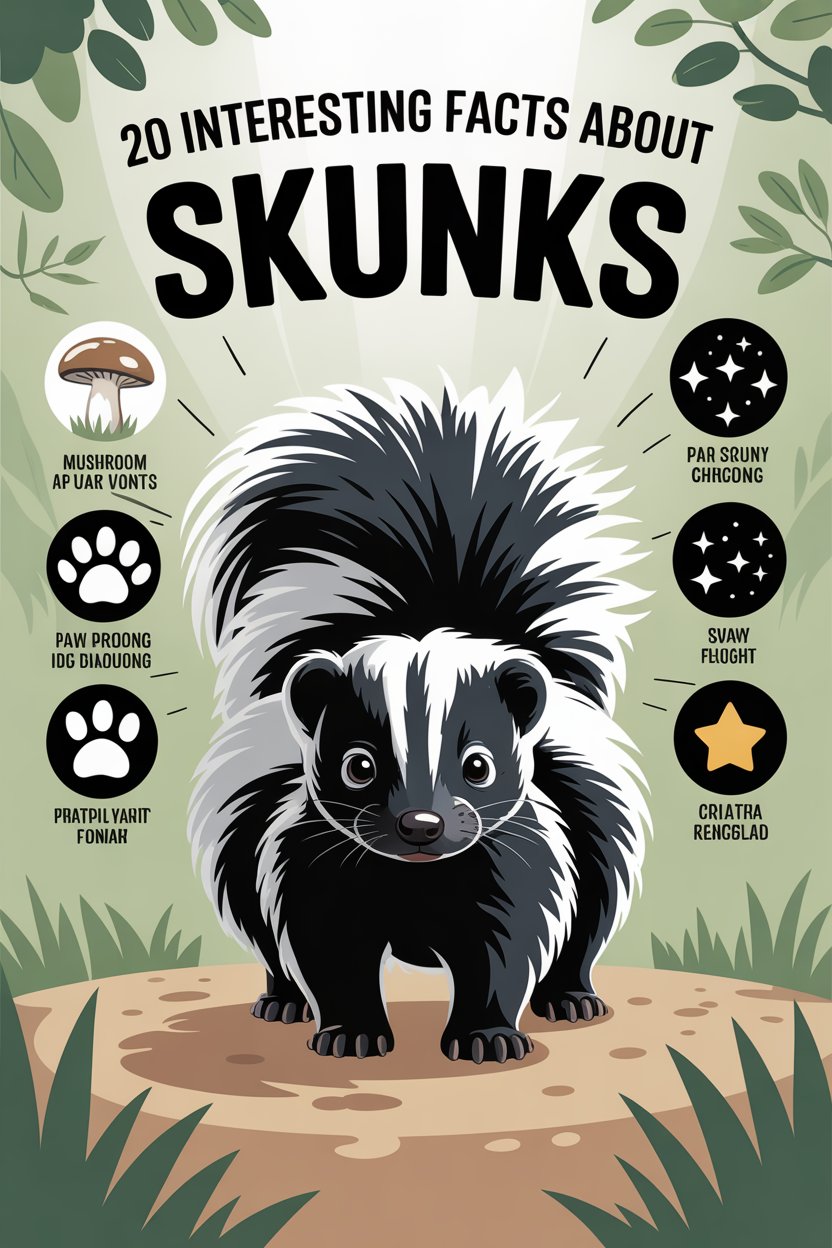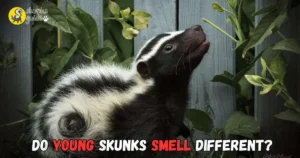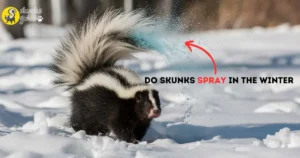20 Interesting Facts About Skunks (Kids & Adults Guide)
Skunks are far more than just their notorious odor. From surprising defenses to unique behaviors, these black-and-white mammals are full of personality and ecological value. Whether you’re a homeowner, parent, gardener, or simply curious, here are 20 interesting facts about skunks that might just change the way you see them.
Skunk Quick Facts Table
| Category | Details |
|---|---|
| Scientific Family | Mephitidae |
| Common Species | Striped, Spotted, Hooded, Hog-nosed |
| Average Lifespan | 2–4 years in the wild; up to 10 in captivity |
| Size | 20–30 inches (including tail) |
| Activity | Nocturnal |
| Diet | Insects, small rodents, berries, eggs, grubs |
| Natural Enemies | Great horned owls, foxes, coyotes |
| Defense Mechanism | Spray from scent glands, accurate up to 10 feet |
| Legal as Pets | Some U.S. states allow with permits |
1. Skunks Can Spray Up to 10 Feet
Skunks have specialized glands that can project a strong-smelling oily spray up to 10 feet. It’s their primary defense against threats.
2. They Give Warning Signs Before Spraying
Before releasing their spray, skunks will stomp their feet, hiss, and lift their tails. It’s a built-in warning system to avoid confrontation.
3. Skunks Are Nocturnal Animals
They are most active at night and sleep during the day. This is why skunk sightings are usually around dusk or dawn.
4. Skunk Babies Are Called Kits
Skunks typically give birth in spring to litters of 4–6 kits, which stay with their mother until late summer.
5. Skunks Eat Garden Pests
They help control insect populations by feeding on grubs, beetles, caterpillars, and even rodents. A skunk in your garden might be more helpful than harmful.
6. Spotted Skunks Can Do Handstands
When threatened, spotted skunks often balance on their front paws while raising their tails in the air before spraying—a unique acrobatic warning display.
7. Skunks Are Immune to Snake Venom
Skunks are one of the few animals that can survive bites from venomous snakes like rattlesnakes, allowing them to prey on them safely.
8. They Glow Under UV Light
When exposed to blacklight, skunk fur fluoresces. Scientists are still exploring the reason behind this natural glow.
9. They Don’t Smell Unless Threatened
Skunks aren’t naturally smelly. Their scent glands only activate when they feel endangered.
10. Skunks Can Spray Multiple Times
A skunk can spray 5 to 6 times in a row, but afterward, it may take several days to produce more of the defensive liquid.
11. Skunk Spray Can Cause Temporary Blindness
The spray isn’t just unpleasant—it can temporarily blind and disorient predators, giving the skunk time to escape.
12. They Have Poor Eyesight
Skunks can’t see well beyond a few feet, which is why they often fall victim to road accidents.
13. Most Skunks Can’t Climb Well
While raccoons and squirrels scale fences and trees with ease, skunks prefer digging and walking. However, spotted skunks are an exception—they can climb.
14. Skunks Are Solitary
They typically live and hunt alone except during mating season or when mothers are raising their kits.
15. Their Coloration is a Natural Warning
The bold black-and-white pattern is a universal warning in nature that signals “stay away.”
16. Skunks Can Swim
Although not their preferred mode of travel, skunks are capable swimmers and will cross small bodies of water if needed.
17. Some Skunks Share Dens in Winter
During colder months, multiple females may share a den to conserve heat, although males usually remain solitary year-round.
18. They Are Omnivorous
Skunks eat both animal and plant matter. Their flexible diet includes insects, fruits, eggs, and even small reptiles.
19. They Can Remember Where They Found Food
Skunks have sharp memories when it comes to easy food sources. Leaving out pet food or unsecured trash may invite nightly visits.
20. Skunks Can Be Kept as Pets in Some States
In certain U.S. states, people can legally own domesticated skunks (with scent glands removed). They are known to be intelligent and affectionate pets.
Why Learn About Skunks?
Understanding skunks helps people live peacefully alongside them. These animals are not aggressive and rarely spray without reason. Learning their behaviors, diet, and ecological value promotes coexistence and humane wildlife practices.
Kid-Friendly Skunk Facts Summary
- Baby skunks are called kits.
- Spotted skunks do handstands before they spray.
- They help gardens by eating bugs and pests.
- Their fur glows under UV light.







